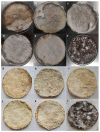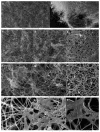Mycelium-Composite Materials-A Promising Alternative to Plastics?
- PMID: 36836324
- PMCID: PMC9965147
- DOI: 10.3390/jof9020210
Mycelium-Composite Materials-A Promising Alternative to Plastics?
Abstract
Plastic waste inefficiently recycled poses a major environmental concern attracting attention from both civil society and decision makers. Counteracting the phenomenon is an important challenge today. New possibilities are being explored to find alternatives to plastics, and one of them refers to mycelium-composite materials (MCM). Our study aimed at investigating the possibility of using wood and litter inhabiting basidiomycetes, an underexplored group of fungi that grow fast and create strong mycelial mats, to produce biodegradable materials with valuable properties, using cheap by-products as a substrate for growth. Seventy-five strains have been tested for their ability to grow on low-nutrient media and to form compact mycelial mats. Eight strains were selected further for evaluation on several raw substrates for producing in vitro myco-composites. The physico-mechanical properties of these materials, such as firmness, elasticity and impermeability, were analyzed. Abortiporus biennis RECOSOL73 was selected to obtain, at the laboratory scale, a real biodegradable product. Our results suggest that the strain used is a promising candidate with real possibilities for scalability. Finally, corroborating our results with scientific available data, discussions are being made over the feasibility of such technology, cost-effectiveness, scalability, availability of raw materials and, not least, where future studies should be directed to.
Keywords: Abortiporus biennis; biodegradable materials; fungal cultures; mycelial composites.
Conflict of interest statement
The authors declare no conflict of interest.
Figures






References
-
- Directive (EU) 2019/904 of the European Parliament and of the Council of 5 June 2019 on the Reduction of the Impact of Certain Plastic Products on the Environment. [(accessed on 12 December 2022)]. Available online: http://data.europa.eu/eli/dir/2019/904/oj.
-
- Abhijith R., Ashoka A., Rejeesh C.R. Sustainable packaging applications from mycelium to substitute polystyrene: A review. Mater. Today: Proc. 2018;5:2139–2145. doi: 10.1016/j.matpr.2017.09.211. - DOI
-
- Asore E.P. Green packaging: Mushroom based packaging for sustainable development in Nigeria (a descriptive perspective) CJMSE. 2021;21:272–290.
-
- Aquino M., Rugolo M., Robledo G., Kuhar F. Evaluation of mycelium composite materials produced by five Patagonian fungal species. Maderas-Cienc Tecnol. 2022;35:1–14. doi: 10.4067/S0718-221X2022000100435. - DOI
LinkOut - more resources
Full Text Sources
Other Literature Sources

